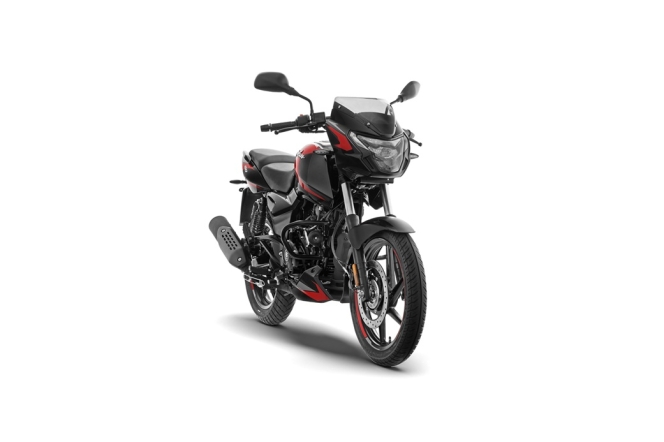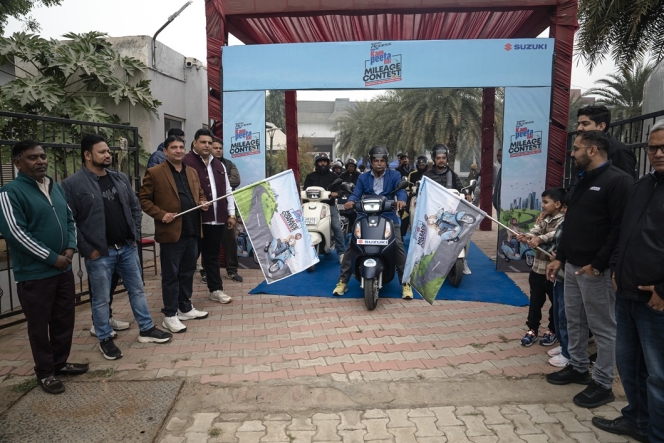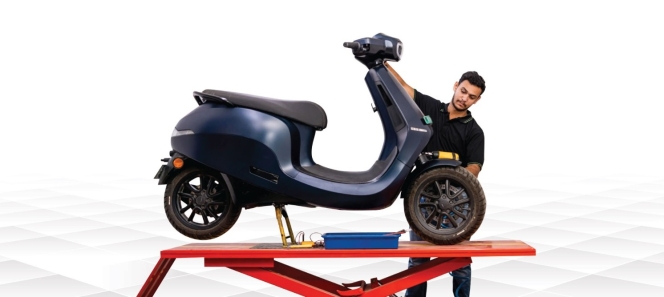
Bajaj Auto has launched the most powerful Pulsar yet in the form of Pulsar NS400Z. The only other motorcycle that Bajaj Auto has been offering for some time is the Dominar 400.
Marking a significant step ahead for the Pulsar motorcycle range, which began its journey with the Pulsar 150 and Pulsar 180 in 2001, the new offering – as part of the NS range which includes the NS125, NS160 and NS200 – flaunts an LED headlamp, digital instrument console and Bluetooth connectivity.
As a flagship motorcycle, the NS400Z reflects dynamism and muscularity that has been the hallmark of the NS range, mentioned a company source. So, a part of the styling theme of the motorcycle is the signature lightning bolt DRL, Champagne Gold USD forks and carbon fibre graphics, a bikini fairing and sporty tail section with underbelly exhaust.
Other than to add to the attractive and sporty appearance of the motorcycle, the above-mentioned attributes also help it to cheat the wind. The 373.27 cc petrol engine produces 40 PS of peak power and 35 Nm of peak torque.
Employing ride-by-wire technology to ensure precise throttle response, the NS400Z comes with a slipper clutch for effortless gear changes and smoother acceleration (as well as deceleration).
Available with advanced ride modes (Road mode for smooth acceleration and stable ABS for daily use; Rain mode for limited power and conservative ABS); Sport mode for heightened throttle response, maximum stopping power for spirited riding, and Off-road mode for optimised low-end torque, controlled braking for rough terrain), the sporting motorcycle is engineered to provide a connected experience through Bluetooth connectivity (pairing with smartphones). The connectivity features include turn-by-turn navigation and music control.
In terms of braking, the NS400Z is packed with dual-channel ABS (with combined ABS technology), Switchable Electronic Traction Control (ETC), adjustable levers (five steps) and large disc brakes (320 mm front and 230 mm rear).
Riding on 17-inch diameter wheels (110/70-17 front and 140/70 R17 rear), the motorcycle has a 1,344 mm wheelbase. It is longer and contributes in terms of agility.
Speaking on the launch, Sarang Kanade, President – Motorcycle Business, Bajaj Auto Ltd, said, "The Pulsar NS400Z is more than just a new motorcycle; it's the embodiment of everything the Pulsar brand stands for - sporty design, power, performance, and an unmatched riding experience delivered to our passionate Pulsarmaniacs and sports motorcycle enthusiasts. It is the ultimate performance machine that will redefine the codes of sports motorcycling in India. It results from engineering expertise, cutting-edge technology, and a deep understanding of what riders truly desire. The Pulsar NS400Z is a great motorcycle for riders looking to start their biking journey or upgrade to a higher-capacity motorcycle. We are confident that with the new Pulsar NS400Z, Pulsar will further strengthen its dominant leadership in the sports segment."
The price of the new Pulsar NS400Z is starting at INR 185,000 ex-showroom Delhi. It is available in four attractive colours.
Bajaj Auto Intros Updated Pulsar 150 Range At INR 108,772
- By MT Bureau
- December 24, 2025

Bajaj Auto, one of the leading two-wheeler and three-wheeler manufacturers, has updated its popular Pulsar 150 motorcycle range. The updates include the introduction of LED headlamps and LED blinkers to the model, which the company states is intended to improve visibility and usability while maintaining the vehicle's design identity.
The updated range is available at the following ex-showroom Delhi prices – Pulsar 150 SD at INR 108,772, Pulsar 150 SD UG at INR 111,669 and Pulsar 150 TD UG at INR 115,481.
The motorcycle retains its frame and stance, though Bajaj has introduced new colour options and graphics. The Pulsar 150 continues to utilise DTS-i (Digital Twin Spark-ignition) technology, which uses two spark plugs to ignite the air-fuel mixture in the combustion chamber, intended to improve combustion efficiency and power output.
The update focuses on integrating modern lighting components into the existing platform, which originally established the sports motorcycling segment in India.
Sarang Kanade, President, Motorcycle Business Unit, Bajaj Auto, said, “The Pulsar 150 has defined performance motorcycling for generations. With this update, we have preserved its classic character while thoughtfully adding modern LED lighting, ensuring the Pulsar 150 remains relevant, recognisable and Definitely Daring.”
Suzuki Motorcycle India Conducts Access Mileage Contest In Palwal
- By MT Bureau
- December 24, 2025

Suzuki Motorcycle India (SMIPL), the subsidiary of Suzuki Motor Corporation, Japan, held a mileage contest for the Suzuki Access scooter in Palwal. The event involved 35 participants, including current owners and prospective buyers, to test the fuel efficiency of the scooter under city driving conditions.
The initiative is part of the brand’s ‘Pickup Bhi, Mileage Bhi’ strategy, which focuses on balancing engine performance with fuel economy and build quality.
The event was organised in partnership with RV Suzuki in Palwal. The participants, all of whom had purchased their scooters within the last year, followed a specific testing protocol: a designated 20-kilometre circuit on city roads, scooters were operated on a full tank, then refilled at the end of the journey to calculate the exact fuel consumed. Potential customers were provided with test rides and the opportunity to interview existing owners regarding reliability and comfort.
Deepak Mutreja, Vice-President, Sales & Marketing, Suzuki Motorcycle India, said, “The Suzuki Access Mileage Contest places a strong focus on fuel efficiency, bringing our brand promise of ‘Pickup Bhi, Mileage Bhi, Shandar Quality Ke Sath’ to life. By riding on city roads, participants experience the scooter’s real-world mileage. Along with mileage, customers also get to experience the quality and reliability that have made the Access a trusted choice of over 6 million customers. We appreciate the participation from customers in Palwal. We will continue to extend such on-ground initiatives to more cities across India, allowing customers to connect closely with out two-wheelers and witness their performance firsthand.”
The company intends to expand these on-ground initiatives to additional cities across India to demonstrate the performance of its two-wheeler portfolio in local environments.
Ola Electric Launches Hyperservice Centres With Same-Day Service Guarantee
- By MT Bureau
- December 23, 2025

Bengaluru-based electric vehicle maker Ola Electric has expanded its Hyperservice initiative by launching dedicated centres that offer a same-day service guarantee for eligible customers at no extra cost. The company will upgrade its existing service infrastructure into Hyperservice Centres, beginning with a facility in Indiranagar, Bengaluru.
The expansion is intended to reduce service lead times and increase transparency through a digital workflow.
The Hyperservice Centres include several facilities for customers and technical upgrades for vehicle maintenance. The waiting area includes a lounge and Wi-Fi connectivity for customers. Real-time visibility of the servicing stages is provided via the Ola Electric app. Going forward, the company plans to upgrade selected centres across India in the coming weeks.
Ola Electric has also transitioned Hyperservice into an open platform. This move makes the company’s spare parts, diagnostic tools, and training modules available to independent garages, mechanics, and fleet operators.
Under this model, parts can be purchased directly through the Ola Electric app or website. This is intended to allow garages and customers to access components without the use of intermediaries.
“As part of the ongoing service upgrade we are reimagining many of the fundamental aspects of the service experience. We see it as a core part of Ola ownership, and it needs the same level of innovation as the product itself. With Hyperservice Centres, we are setting a new benchmark – same-day service guarantee. At no extra cost for any customer. This is about using technology, process redesign and scale to remove friction and give every Ola customer a faster, simpler and more transparent service experience,” said the company in a statement.
The company has rolled out an in-app service appointment feature nationwide. The tool allows users to select service slots, track the status of their vehicle, and manage maintenance requirements within the unified platform to replace traditional booking methods.
Hajime Aota Appointed Chairman Of Yamaha Motor India Group
- By MT Bureau
- December 23, 2025

India Yamaha Motor, one of the leading two-wheeler manufacturers in the country, has announced the appointment of Hajime Aota as the Chairman of Yamaha Motor India Group, effective from 1 January 2026. He is set to succeed Itaru Otani, who held the position since November 2024.
The appointment comes as Yamaha continues its focus on the premium segment and digital integration within the Indian two-wheeler market.
Aota joins the Indian operations with experience in corporate strategy, planning and venture business development. He has held leadership roles in Japan, the United States and the United Kingdom.
Prior to this role, Aota served as Executive Officer at Yamaha Motor Co, and Chief General Manager of the Corporate Strategy Centre at the global headquarters in Japan. In these positions, he managed corporate strategy, sustainability and digital transformation.
He has also worked as Chairperson of Yamaha Motor Ventures & Laboratory Silicon Valley (YMVSV) overseeing investments in robotics, transportation, fintech and health technologies. He has also contributed towards Yamaha Motor Group’s long-term growth strategy.
Aota is a graduate of Keio University and holds a qualification from the Program for Leadership Development at Harvard Business School.
Hajime Aota, said, “I am very excited to begin my journey in India, one of the world’s most dynamic and diverse two-wheeler markets. The rapidly evolving aspirations of Indian consumers, especially the youth, align strongly with Yamaha’s focus on premium products, innovation, and a customer-centric approach. Leading Yamaha in India is a significant responsibility, and my focus is on strengthening the brand by delivering products that seamlessly combine Yamaha’s global engineering excellence with the evolving needs of Indian riders. I look forward to working closely with our teams and partners to drive sustainable growth and reinforce Yamaha’s presence in this important market.”






Comments (0)
ADD COMMENT